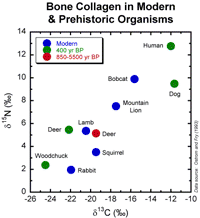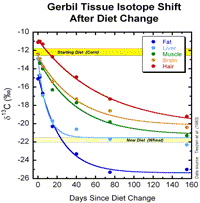ANIMAL STUDIES: Diet Discrimination, Tissue Differences and
Diet Changes Over Time
 |
 |
Figure 1. Bears that eat a diet of just
nuts and berries have tissue d15N and d13C values lower than
those of bears that also eat salmon (which is higher up the
food chain). View larger image.
|
Figure 2. Collagen preserved in modern
and fossil bones records an organism’s relative diet.
Carnivores have higher d15N
and d13C values than herbivores.
View larger image.
|
 |
 |
Figure 3. Different tissues of gerbils
have varying d13C values. Brain, muscle, and
liver tissue best reflect the d13C signature
of a gerbil’s diet. Note the large offset between diet
and fat! Fat typically has lower d13C values than other tissues.
View larger image.
|
Figure 4. When a gerbil’s
diet is switched to food with a different d13C
value, its tissues change over time to reflect this. This
happens as carbon in the tissues is replaced. Some tissues
show this change more rapidly than others. For example, liver
tissue achieves the d13C value of the new
diet in less than 80 days, whereas hair takes well over twice
as long. View larger image.
|
References
- Lyon, T.D.B. and Baxter, M.S., 1978. Stable carbon isotopes in human tissues. Nature, 273: 750-751.
- O'Connell, T.C. and Hedges, R.E.M., 1999. Investigations into the effect of diet on modern human hair isotopic values. American Journal of Physical Anthropology, 108: 409-425.
- Ostrom, P.H. and Fry, B., 1993. Sources and Cycling of Organic Matter within Modern and Prehistoric Food Webs. In: M.H. Engel and S.A. Macko (Editors), Organic Geochemistry. Plenum Press, New York, pp. 785-798.
- Schwarcz, H.P., Melbye, J., Katzenberg, M.A. and Knyf, M., 1985. Stable isotopes in human skeletons of southern Ontario: Reconstructing paleodiet. Journal of Archaeological Science, 12: 187-206.
- Tieszen, L.L., Boutton, T.W., Tesdahl, K.G. and Slade, N.A., 1983. Fractionation and turnover of stable carbon isotopes in animal tissues: Implications for d13C analysis of diet. Oecologia, 57: 32-37.
|
|




